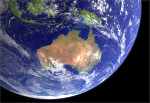For those of us fortunate enough to have been part of Melbourne's 1956 Olympic Games,
the memories will never be forgotten.
The Games took place between November 22 and December 8 - I had just turned 16 and was in
my first year of full-time employment as a Trainee Technician with the PMG's Department.
Planning for these Games, the first to have ever been held in the Southern Hemisphere, had
been progressing for several years, with several new sporting arenas and venues being constructed.
The main venue for Track and Field events was the Melbourne Cricket Ground, where a brand
new multi-tiered Northern Stand had been built. These works began jjust after the completion of the 1955 Australian Rules football
season, with the demolition of the very old wooden stand which had been there for hundreds of years!
During the 1956 footy season, matches were still played at the MCG, but the entire northern
stand area was a major construction zone.
After the 1956 footy season ended in September, the entire arena was dug up and relaid, with
track and field tracks being installed.
Other new venues built included the Olympic Swimming Pool in Batman Avenue and a vast athletes'
accommodation village in the northern suburb of Heidelberg.
The four track Cycling events were held in December at
the The Melbourne Olympic Velodrome (or Olympic Park Velodrome). One main grandstand on one side with seating on
the other gave the venue an estimated capacity of between over 10,000. The venue was demolished in 1972.
The finals of the Soccer were held at the MCG.
Many events were held at country and subueban locations.
The Melbourne CBD was decorated with banners, bunting, signs. artwork,
and commemorative structures. Huge flags were placed on many city buildings. The Navy came to Port Melbourne - many suburban
town halls were illuminated at night for the Games.
The Games opened on Thursday November 22 with a massive
attendance at the MCG. The day had been declared a Special Public Holiday for the Melbourne Metro area - gazetted as "The
Olympic Day".
For the following ten days, Melbournians went wild, fuelled by Australia's amazing successes
in many events, especially swimming and hurdling.
Despite the international tensions of 1956 – or perhaps because of them –
a young Melbournian, John Wing, came up with a new idea for the closing ceremony. Instead of marching as teams, behind their
national flags, the athletes mingled with one another as they paraded into and around the arena for a final appearance before
the spectators. That began an Olympic tradition that has been followed ever since.
Entry to the events at the MCG was by tickets, which were sold at Myer's Department Store
in Bourke St - the Cafetaria had been converted into a huge ticketing agency, and we stood in long queues for hours.
The opening ceremony was sold out months in advance, but I managed to get a ticket for
the MCG for Tuesday December 4. My seat was in the southern stand, in Bay 12, about ten rows back from the fence. As well
as Track and Field events, a final of the Soccer Tournament was played on that day, bertween India and Yugoslavia.
During one of the breaks, I walked around to the new Northern Stand, and climbed to the top
deck, just above the Olympic Flame, for a big view of the arena..
Many employers were sympathetic to staff taking time off to attend the MCG events during working
days - I recall that, as Trainee Technicians, were were given an extra holiday to go to the MCG!
On the evening of Thursday December 6, with two PMG mates, we went to the Cycling at
the Olympic Velodrome, in Swan St, just across the way from the MCG.
The Men's Marathon was held on Saturday December 1, along Dandenong Rd, 30 km from the MCG
to the SE outer suburb of Dandenong. I recall that I went with a mate, on our bikes, to Caulfield, to watch the runners
go past.
Television officially started in Melbourne on the opening day of the Games, November 22, when
the ABC's ABV2 and the commercial station HSV7 went on the air. I can remember looking in the windows of electrical
shops which had TV sets to watch the Games, and we jostled for good positions!
So, I have fond memories of the 1956 Summer Melbourne Olympic Games, an experience to remember.
The images below are from my own album!
.

